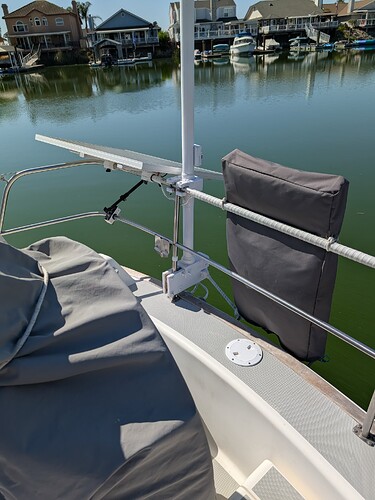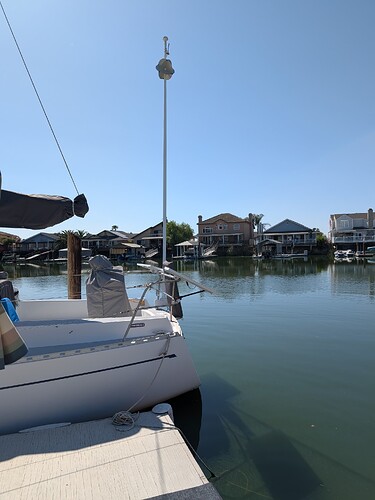I have an ICOM VHF with AIS receiver - most of you will be familiar with this radio.
I also have a full AIS transponder independent of the radio.
The objective was to get some AIS receive redundancy should I experience a transponder failure …esp. offshore. After nearly 10 years I have not had a device failure. Pretty happy with that reliability.
But
I can not say as much for the mast top whip antenna which is shared by the VHF and AIS transponder via an antenna splitter. I have had to replace a broken antenna three times over that same 9 years. One of those antenna failures occurred about half way back from Hawaii. In that case I had to rig my emergency antenna to a long RG 58 cable (part of my emergency kit) which went up on the flag halyard and used that for 1000 miles. It was not ideal. I want better backup capability.
On original install, I wired low loss LMR 400 coax to the masthead antenna from the splitter located close to the chart table - about 65 feet of cable overall with three Barrel joints along the way.
.
The cable looks good inside the boat as far as the RF connector at the mast base. The cable does not appear to be shorted, so I suspect an issue with the masthead connector or some other issue with cable condition aloft.
Meanwhile I am a lot less enthusiastic about climbing the mast than I have been in the past. I have never been comfortable with this climb and when I get to the mast top, I find it extremely difficult to do useful work. Hiring someone to climb and troubleshoot this is an expensive exercise as is pulling the mast and repairing on the ground myself.
So… In order to comply with offshore race requirements I must carry a radar reflector at least 13 feet above the water’s surface. I found this really difficult to accomplish reliably with the free standing mast. My solution was to install a 15 foot carbon windsurfer mast on my transom. I have built a reliable mount and basically skewered a classic aluminum radar reflector with the pole and got the reflector to ride about 15’ above the water. Sweet! But there is a tantalizing empty masthead on my new “mast”. So I used that real estate for my independent AIS GPS receive antenna. Works like a charm.
So, years after installing the radar “mast”, I run into the VHF and AIS issue described earlier.
I really did not like not having a good AIS signal. I needed a temp fix and that temp fix could become my emergency backup when I finally repair the masthead issue, So I installed an AIS rcv/xmit stub antenna right below the AIS GPS receiver at the top of the radar pole. While range is somewhat reduced due to reduced height, the gain is improved somewhat by elimination of the splitter and reduction in cable length, Overall it is close to a wash sensitivity wise. Range will be reduced by the lower height of the antenna. I am getting about 15 NM in open water. I can live with that.
But it has worked so well (and so beautifully accessible if a problem arises) that I am now thinking of installing a hi gain VHF antenna on the same pole Just below the radar reflector which is below the AIS antenna which is below the AIS GPS receiver antenna. Yea, it’s getting crowded but everything is fairly light.
I had originally thought ti install a 36 inch whip similar to a masthead antenna but I then thought, why not just go with one of those fiberglass pole antennas one might see on a power boat? I would align this with the radar mast, stand it off a few inches and we now have a complete backup system. I think,
I wonder if any of you RF experts could shed any light on the performance impact of installing (for example) a six foot fiberglass antenna standing off a carbon fiber pole (2.5" diameter) . The standoff would be about 2 inches or so. The base of the new antenna would wind up about 8 feet above the water.
My biggest concern would be creating an RF shadow behind the 2.5" carbon mast. I really can not allow the new antenna to flop around in the breeze, it needs to be integrated to the radar mast and, as a result, behind, on the side of, or in front of the radar mast pole and vertically aligned with it.
Eventually I will have the mast out to deal with whatever problems I find but in the meantime I have an operating system and am left with a good emergency backup for both AIS and VHF when the issue with the primary antenna is resolved.
Could any RF experts comment on this? esp the RF shadow issue. Also any general comments, criticism/alternative approaches are welcome.

